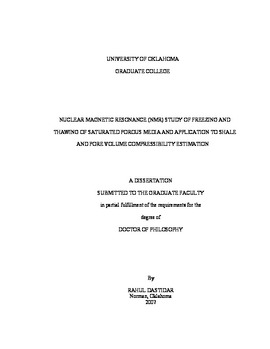| dc.contributor.advisor | Sondergeld, Carl H., | en_US |
| dc.contributor.author | Dastidar, Rahul. | en_US |
| dc.date.accessioned | 2013-08-16T12:20:55Z | |
| dc.date.available | 2013-08-16T12:20:55Z | |
| dc.date.issued | 2007 | en_US |
| dc.identifier.uri | https://hdl.handle.net/11244/1265 | |
| dc.description.abstract | Conventional logging tool response is complicated by the presence of shale making it difficult to interpret the log response. Water saturation in shales assumes the shales are filled with brines found in nearby sands. In gas shales where brines cannot be sampled it is impossible to measure shale water saturation. The porosity and water saturation of six unpreserved shale samples and their pulverized equivalents were measured with NMR. The estimated NMR porosity from the cuttings is always lower than plug porosity but within +/- 1.0 p.u. The estimated water saturation from cuttings is about 60% lower than that of plugs and may be a function of cutting size. Ninety percent of the water present in the all the six shale plugs/cuttings is bound to the surface of the core either as hydration water or by capillary forces. An obvious drawback of the study is the use of unpreserved core plugs. Immersion of cuttings in water and oil indicate the estimation of porosity and water saturation by NMR was possible in oil based mud. | en_US |
| dc.description.abstract | NMR is used routinely in the oil and gas industry to determine in-situ water saturation and bound or non movable water saturation. It is used for rock typing and to provide estimates of permeabilities. Extending these uses to zones of permafrost and hydrate requires understanding NMR measurements in the presence of cold temperature and ice. The porous media in permafrost region generally contain ice in addition to brine. The presence of ice complicates the fluid dominated NMR response. The main objective of this study is to understand the freeze-thaw behavior of NMR in saturated reservoir rocks using a 2 MHz (oilfield operating frequency) NMR spectrometer and a Carr, Purcell, Meiboom and Gill (CPMG) pulse sequence technique. In this experimental based study, brine saturated reservoir and synthetic core plugs were temperature cycled from 22° C to -12° C. Core porosities ranged from 18% to 37% while Klinkenberg permeabilities ranged from 10 md to 5000 md. Quartz is the dominant mineral present in all the core plugs. Effective surface relaxivities were determined using high pressure mercury injection test on parallel samples. The surface relaxivity ranged from 21.5 mu/sec to 59.7 mu/sec. Attempts to estimate the surface relaxivity of the ice produced mixed results. Temperature effects are shown to be important in estimating porosity at low temperature; failure to correct for temperature lead to overestimation of porosity. Temperature dependent frequency shifts in T2 distribution are attributed to the temperature dependency of surface relaxivity. Liquid water is present at temperature as low as -12° C. Hysteresis in the NMR response exists between freezing and thawing. Melting is a gradual process, and one model suggests that ice in small pores thaws before the ice in big pores thaws. Indirect evidence suggests that the surface relaxivity of ice is similar to that of the rock matrix. | en_US |
| dc.description.abstract | Many pore volume compressibility estimation measurement are performed with non-polar fluids such as kerosene, mineral oil, air and nitrogen. Applying NMR to brine saturated core plugs subjected to hydrostatic stress, allowed us to measure compressibility in the presence of natural polar fluid. NMR measured compressibilities to 5000 psi were compared to those measured using helium. For 5/6 samples, measurements from brine saturated yielded higher compressibility then when filled with helium. The role of water in softening clays and hydrating bonds cannot be overlooked when measuring compressibility. | en_US |
| dc.description.abstract | This study has three parts each focusing on applying NMR to classical problem; first, I studied the process of freezing and thawing in reservoir sandstones; second, I study the application of NMR to the determination of porosity and water saturation of shales, and to evaluate if meaningful porosity and water saturation values could be measured on drilling cuttings using NMR; and third, I measured pore volume compressibility using NMR. | en_US |
| dc.format.extent | xxi, 179 leaves : | en_US |
| dc.subject | Oil reservoir engineering. | en_US |
| dc.subject | Nuclear magnetic resonance. | en_US |
| dc.subject | Engineering, Petroleum. | en_US |
| dc.subject | Porosity. | en_US |
| dc.title | Nuclear magnetic resonance (NMR) study of freezing and thawing of saturated porous media and application to shale and pore volume compressibility estimation. | en_US |
| dc.type | Thesis | en_US |
| dc.thesis.degree | Ph.D. | en_US |
| dc.thesis.degreeDiscipline | Mewbourne School of Petroleum and Geological Engineering | en_US |
| dc.note | Source: Dissertation Abstracts International, Volume: 68-10, Section: B, page: 6938. | en_US |
| dc.note | Adviser: Carl H. Sondergeld. | en_US |
| ou.identifier | (UMI)AAI3283875 | en_US |
| ou.group | Mewbourne College of Earth and Energy::Mewbourne School of Petroleum and Geological Engineering | |
